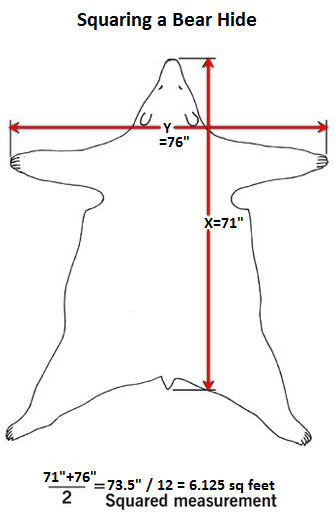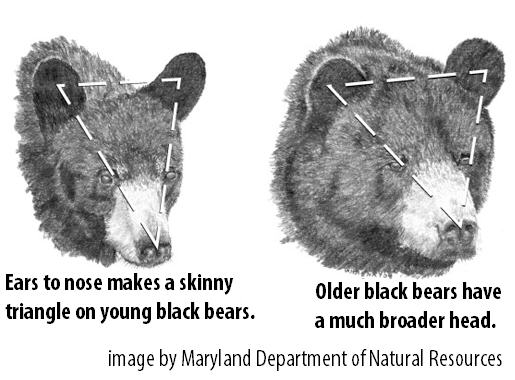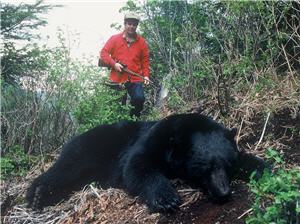
Countless articles, books, and DVDs tell us how to age and score whitetail bucks in the field. However, you’ll very little advice is available on how to judge the age of a bear. That’s unfortunate because bears can be particularly difficult to judge for hunting. Use these techniques to decide whether a bear is the one you want to release your arrow or pull the trigger on. 
In this article I'll discuss a black bears weight, how to measure a bear hide, bear skull measurement and determining the age of a black bear.
Learn to Judge a Bear in the Field
Bears can be difficult for novices and even experienced hunters to judge in the field. The best approach with bears you spot while hunting is to decide whether a bear fits in one of three categories:
- Too young to shoot (1-2 years old), a good, average bruin (3-4 years) or
- A large mature bear (5 years-plus) that you definitely don’t want to pass up
Just as with deer and other antlered game, the basic rule of thumb should be that if you’re not sure about the animal’s size and age, it’s probably best not to shoot or release your arrow. Once you make that decision, it’s too late to change your mind. The only exception would be if it’s your first bear ever and you’ll be happy with any legal bruin harvest.
Click here for a +LARGER view of Black Bear Facts
 If you’ve never hunted bears much, try to watch videos and study photos in books. Pay attention to how different an old, heavy boar bear looks from a young, lean male or female bear. Memorize the images of a trophy bear versus a small bear. This will help you know when an animal steps out whether it’s a brute or a baby. In the end, three major factors are used to judge bears: weight, squared hide, and skull size.
If you’ve never hunted bears much, try to watch videos and study photos in books. Pay attention to how different an old, heavy boar bear looks from a young, lean male or female bear. Memorize the images of a trophy bear versus a small bear. This will help you know when an animal steps out whether it’s a brute or a baby. In the end, three major factors are used to judge bears: weight, squared hide, and skull size.
Extra Tip: “Black Bear Hunting,” by Richard Smith, is one of the best references available for learning to judge bruins. You can order that book, as well as instructive DVDs, from the author at Richardpsmith.com.
10 Facts About Black Bear
- Most active shortly before sunrise and after sunset.
- Excellent sense of smell 100% greater than humans.
- Average lifespan is 20 to 35 years.
- Considered a "big game" animal and hunted in 28 of the 50 U.S. states.
- May lose up to 30% of weight during torpor.
- A newborn bear cub weights 1 pound and fits in you hand.
- Can run up to 35 miles per hour.
- Are born with blue eyes that slowly turn black.
- Care for their offspring 18 months.
- Do not hibernate but do enter a state of dormancy in winter called torpor and will leave shelter on warm days to find food.
1. How to Judge the Bears Weight
Three things go into the measure of what makes a bear big. Weight is obviously one. A 150-250 pound bear is average in most areas. Bag a bear lighter than this and you’ll probably be disappointed. A few states even have minimum weights of around 100 pounds for a bear to be legal.
A bear over 250 pounds is above average. One topping 300 pounds is exceptional. A 400 pound-plus bear is enormous. The largest bear ever officially documented was killed in North Carolina by Tennessee hunter Coy Parton using hounds. It weighed 880 pounds. Several other bears over 700 pounds have been taken in the coastal region of that state.
Extra Tip: In addition to North Carolina, check out Pennsylvania and Minnesota. Both have both produced bears over 800 pounds. Most Canadian provinces have also yielded bears over 700 pounds.
Extra Tip: Bears have voracious appetites and that shows up in their stomach. A big bear’s belly tends to hang low, almost touching the ground. If there is substantial daylight between the bear’s mid-section and the ground, pass it up. It’s likely a youngster.
2. Squaring a Bear Hide
 The squared measurement of the hide is a second way to judge bears. Measure the width and length, divide by two and you get the squared size of the bear. Black bears squaring 5-6 feet are about average. A bear over 6 feet is excellent. Seven-foot bears are trophies of a lifetime, likely 400 pound-plus animals.
The squared measurement of the hide is a second way to judge bears. Measure the width and length, divide by two and you get the squared size of the bear. Black bears squaring 5-6 feet are about average. A bear over 6 feet is excellent. Seven-foot bears are trophies of a lifetime, likely 400 pound-plus animals.
Extra Tip: When looking for a bear that will square over 6 feet, note the position of its ears and their size. If the ears look small on a bear, it’s likely a trophy animal. If they appear to grow out the side of the head, that also indicates a very large bear. If ears poke up on top of the bear’s head and look large, that’s likely a youngster. Hold off and let him grow a bit.
How to measuring a bear hide: Example formula for getting a 'squared' measurement.
Length (tip of nose to tip of tail) = X
Width (Front claw tip to claw tip) = Y,
Lets assume X=71" and Y= 76". X (71") + Y (76") /2 = Z (73.5") or convert to squared feet Z (73.5") /12 = 6.125' (FT).
3. How to Determine Skull Measurement of a Bear
 The final measurement of a trophy bear is the skull. This is the one used for record-book purposes to judge the trophy quality of a bear. Measure the width of the skull and the length without the lower jaw. Add those two together for the score.
The final measurement of a trophy bear is the skull. This is the one used for record-book purposes to judge the trophy quality of a bear. Measure the width of the skull and the length without the lower jaw. Add those two together for the score.
A black bear must measure 20 inches to make Boone & Crockett bear skull score for  the current recording period. It takes a 21-incher to qualify for the all-time B & C record book. A bear scoring 18 inches makes the Pope & Young record book.
the current recording period. It takes a 21-incher to qualify for the all-time B & C record book. A bear scoring 18 inches makes the Pope & Young record book.
Extra Tip: You can often judge a bear’s size and age by the head. An old boar’s head looks blocky and thick. The overall appearance of the head, though, may look small compared to the enormous body it sits on top of. Female heads and those of younger males look more streamlined and tapered in shape and seem to fit the size of their bodies better.
Extra Tip: Field evaluation for Boone and Crockett score pdf - LINK
4. How to Judge the Age of a Bear
 |
| Author Gerald Amy with his best bear ever, a 400 pound plus, 7 foot bear from Vancouver Island, Canada. |
Those are all visible measurements of a bear’s size. Many hunters, though, like to consider a fourth factor when deciding whether to harvest a bear. It’s one many veteran deer hunters have also become more and more concerned about: age.
Like whitetails, a bear five-years or older should be considered mature and a good one to take. But bears can live much longer in the wild than most deer. The oldest black bear on record was a 39-year old female from Minnesota.
Extra Tip: Attitude can often tell you if a bear is an old, trophy animal. An older bear moves deliberately, often ploddingly. He’s in no hurry and acts like he’s not afraid of anything. If other bears tend to scurry out of the way when he approaches, you’re looking at a mature, trophy bear. Take him!
- 154975 views

